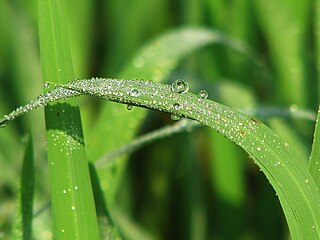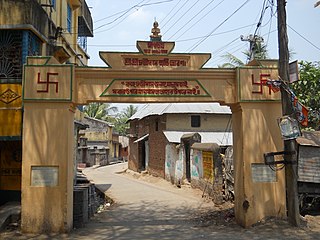Related Research Articles

Shaktism is one of the several major Hindu denominations wherein the metaphysical reality, or the godhead, is considered metaphorically to be a woman.

The music of West Bengal includes multiple indigenous musical genres such as Baul, Ramprasadi, Bishnupuri Classical, Kirtan, Shyama Sangeet, Rabindra Sangeet, Nazrul Geeti, Dwijendrageeti, Prabhat Samgiita, Agamani-Vijaya, Patua Sangeet, Gambhira, Bhatiali, Bhawaiya, Bengali Rock.

Poush is the 9th month of both the Bengali calendar and the Nepali calendar. It overlaps December and January of the Gregorian calendar. It is the first month of the winter season. This month marks the start of Winter in the Bengali calendar.

Birbhum district is an administrative unit in the Indian state of West Bengal. It is the northernmost district of Burdwan division—one of the five administrative divisions of West Bengal. The district headquarters is in Suri. Other important cities are Bolpur, Rampurhat and Sainthia. Jamtara, Dumka and Pakur districts of the state of Jharkhand lie at the western border of this district; the border in other directions is covered by the districts of Bardhaman and Murshidabad of West Bengal.

The culture of West Bengal is an Indian culture which has its roots in Bengali literature, music, fine arts, drama and cinema. Different geographic regions of West Bengal have subtle as well as more pronounced variations between each other, with Darjeeling Himalayan hill region and Duars showing particularly different socio-cultural aspects.
Patiram is a village in Balurghat CD Block of Balurghat subdivision in Dakshin Dinajpur district in the state of West Bengal in India. Patiram is situated beside of Atreyee River. It is 11 km away from the district headquarters Balurghat.

Poush Mela is an annual fair and festival that takes place in Santiniketan, in Birbhum District in the Indian state of West Bengal, marking the harvest season. Commencing on the 7th day of the month of Poush, the fair officially lasts for three days, although vendors may stay until the month-end as per the university regulations. From 2017 onwards, the fair lasted for six days. The key characteristic of this fair include live performances of Bengali folk music, such as baul, kirtan and Kobigan.
Labhpur is a census town in Labpur CD block in Bolpur subdivision of Birbhum district in the Indian state of West Bengal. It is known to the outside world as the native place of Tarashankar Bandopadhyay and one of the 51 Shakti Peethas.

Nanoor, is a village in Nanoor CD block in Bolpur subdivision of Birbhum district in West Bengal. Nanoor is the birthplace of 14th century lyric poet Chandidas of Vaishnava Padavali fame. It is developing as a craft centre with NGO support. With the massacres in 2000, Nanoor was in intense media focus.
Ilambazar is a census town, with a police station, in Ilambazar CD block in Bolpur subdivision of Birbhum district in the Indian state of West Bengal.
Jaydev Kenduli is a village and gram panchayat in Ilambazar community development block in Bolpur subdivision of Birbhum District in the Indian state of West Bengal. It is believed by many to be the birthplace of Jayadeva, an issue that is still debated by scholars. It has developed as a religious centre with many temples and ashramas (hermitages). An annual fair, popular as baul fair, is organized on the occasion of Makar Sankranti.
Fairs in Birbhum refers to the many fairs that take place in Birbhum district in the Indian state of West Bengal.
Raipur is a village under Raipur–Supur gram panchayat of Bolpur Sriniketan block in Bolpur subdivision of Birbhum district in the Indian state of West Bengal.

Dharmaraj is a Hindu deity of death and justice, worshipped by villagers in the traditional Rarh region in the present day Indian state of West Bengal as one of their special village gods. He is represented by a shapeless stone daubed with vermillion and is normally placed under a tree or placed in the open, but sometimes enshrined in a temple. The worship takes place in the months of Baisakh, Jaistha and Asarh on the day of full moon and sometimes on the last day of Bhadro. Dharmaraj is worshipped mainly by all castes.

Hinduism is the largest religious tradition in the Indian state of West Bengal with approximately 70.53% of the population identifying themselves as Hindus. The Hindus in West Bengal mostly belong to the Shakta, minority to Vaishnavite and a small community belong to Shaivite and other denominations. The vast majority of Hindus in West Bengal are Bengali Hindus numbering around 55 million and comprising 60.2% of the state population of 91.35 million (2011) but a notable section of non-Bengali Hindus also exist, particularly among Marwaris, Biharis, Odias, Gurkhas, Sindhis, Gujaratis and various tribal communities such as Koch, Santals, Munda and particularly Adivadis numbering around 9.4 million comprising rest 10.3% of the state population. Hindus have decreased in west bengal due to conversion to Islam which National Commission for Backward Classess(NCBC) notices.

Surul is a census town in Bolpur Sriniketan CD block in Bolpur subdivision of Birbhum district in the Indian state of West Bengal.
Khustigiri is a village in Ilambazar community development block in Bolpur subdivision of Birbhum District in the Indian state of West Bengal. It is 25 kilometres (16 mi) from Suri.
Deucha is a village and a gram panchayat in Mohammad Bazar CD Block in Suri Sadar subdivision of Birbhum district in the Indian state of West Bengal.
Khujutipara is a village in Nanoor CD block in Bolpur subdivision of Birbhum district.
Parota is a census town in Nanoor CD block in Bolpur subdivision of Birbhum district.
References
- 1 2 Das, Prabhat Kumar, Birbhumer Kirtan O Jatragan, Paschim Banga, Birbhum Special issue (in Bengali), February 2006, pp. 311–319
- ↑ Kundu, Chnadan, Birbhumer Baul: Swatantrer Sandhane, Paschim Banga, Birbhum Special Issue, pp. 215–224
- 1 2 Mukhopadhyay, Aditya, Birbhumer Mela, Paschim Banga, Birbhum Special issue (in Bengali), February 2006, pp. 203–214
- ↑ Sarkar, Joydeep, Paryatan Boichitre Birbhum Jela, Paschim Banga, Birbhum Special Issue, pp. 197–202
- ↑ Sen, Suchbrata, Birbhumer Otit O bartaman Samajchitra, Paschim Banga, Birbhum Special Issue, pp. 107–116
- 1 2 3 4 5 6 Mitra, Ajit Kumar, Birbhumer loukik Debdebi, Paschim Banga, Birbhum Special Issue, pp. 321–334